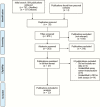Can Hepatitis C Virus Antigen Testing Replace Ribonucleic Acid Polymearse Chain Reaction Analysis for Detecting Hepatitis C Virus? A Systematic Review
- PMID: 28567430
- PMCID: PMC5445222
- DOI: 10.1093/ofid/ofw252
Can Hepatitis C Virus Antigen Testing Replace Ribonucleic Acid Polymearse Chain Reaction Analysis for Detecting Hepatitis C Virus? A Systematic Review
Abstract
The complexity and cost of current diagnostics for hepatitis C virus (HCV) may act as a prevention to the scale-up of treatment in the developing world. Currently, ribonucleic acid (RNA)-polymerase chain reaction tests are the gold standard. However, there is potential for the use of simpler and cheaper antigen tests to confirm HCV infection in different clinical settings. We evaluated the sensitivity and specificity of antigen assays. This was compared with the reference-standard RNA assays. A subanalysis also assessed Architect core antigen test, which is the only commercially available antigen test on the market. In 24 datasets, evaluating HCV-antigen assays in 8136 samples, the percentage of HCV-antigen positive, HCV-RNA negative was 0.57%. The percentage HCV-antigen negative, HCV-RNA positive was 3.52%. There is strong evidence that antigen detection performs as well as RNA-based assays for HCV management. The use of antigen tests could improve access to HCV care in underresourced healthcare settings.
Keywords: HCV RNA.; HCV antigen; HCV diagnostics.
Figures
Similar articles
-
Role of hepatitis C virus core antigen assay in hepatitis C care in developing country.Egypt Liver J. 2021;11(1):77. doi: 10.1186/s43066-021-00146-z. Epub 2021 Sep 18. Egypt Liver J. 2021. PMID: 34777874 Free PMC article.
-
Laboratory Evaluation of Hepatitis C Virus Infection in Patients Undergoing Hemodialysis from North East India.J Clin Exp Hepatol. 2022 Mar-Apr;12(2):475-482. doi: 10.1016/j.jceh.2021.05.011. Epub 2021 Jun 16. J Clin Exp Hepatol. 2022. PMID: 35535106 Free PMC article.
-
HCV core antigen as an alternative to HCV RNA testing in the era of direct-acting antivirals: retrospective screening and diagnostic cohort studies.Lancet Gastroenterol Hepatol. 2018 Dec;3(12):856-864. doi: 10.1016/S2468-1253(18)30271-1. Epub 2018 Sep 28. Lancet Gastroenterol Hepatol. 2018. PMID: 30274834
-
Diagnostic performance of hepatitis C virus core antigen testing for detecting hepatitis C in people living with hepatitis B: a systematic review and meta-analysis.Infect Dis Poverty. 2024 Dec 2;13(1):89. doi: 10.1186/s40249-024-01264-7. Infect Dis Poverty. 2024. PMID: 39617947 Free PMC article.
-
Hepatitis C virus core antigen testing: role in diagnosis, disease monitoring and treatment.World J Gastroenterol. 2014 Jun 14;20(22):6701-6. doi: 10.3748/wjg.v20.i22.6701. World J Gastroenterol. 2014. PMID: 24944462 Free PMC article. Review.
Cited by
-
HCV core antigen plays an important role in the fight against HCV as an alternative to HCV-RNA detection.J Clin Lab Anal. 2021 Jun;35(6):e23755. doi: 10.1002/jcla.23755. Epub 2021 Mar 31. J Clin Lab Anal. 2021. PMID: 33788295 Free PMC article. Review.
-
Interferon-omega: Current status in clinical applications.Int Immunopharmacol. 2017 Nov;52:253-260. doi: 10.1016/j.intimp.2017.08.028. Epub 2017 Oct 12. Int Immunopharmacol. 2017. PMID: 28957693 Free PMC article. Review.
-
HCV Core-antigen Assay as an Effective Alternative to HCV RNA Quantification in Patients With Hepatitis C.In Vivo. 2023 Jul-Aug;37(4):1498-1503. doi: 10.21873/invivo.13234. In Vivo. 2023. PMID: 37369475 Free PMC article.
-
Role of hepatitis C virus core antigen assay in hepatitis C care in developing country.Egypt Liver J. 2021;11(1):77. doi: 10.1186/s43066-021-00146-z. Epub 2021 Sep 18. Egypt Liver J. 2021. PMID: 34777874 Free PMC article.
-
Biomarkers in Detection of Hepatitis C Virus Infection.Pathogens. 2024 Apr 17;13(4):331. doi: 10.3390/pathogens13040331. Pathogens. 2024. PMID: 38668286 Free PMC article. Review.
References
-
- Cooke GS, Hill AM. Diagnostics for resource-limited settings in the era of interferon-free HCV therapy. J Viral Hepat 2015; 22:459–60. - PubMed
-
- UNITAID. Hepatitis C—Diagnostics Technology Landscape Available at: http://unitaid.org/images/marketdynamics/publications/UNITAID-HCV_Diagno.... Accessed 15 August 2016.
-
- PRISMA. PRISMA Statement Available at: http://www.prisma-statement.org/PRISMAStatement/ Accessed 15 August 2016.
-
- Moses L, Shapiro D, Littenberg B. Combining independent studies of a diagnostic test into a summary ROC curve: data‐analytic approaches and some additional considerations. Stat Med 1993; 12:1293–316. - PubMed
-
- Whiting P, Rutjes A, Westwood ME, et al. QUADAS-2: a revised tool for the quality assessment of diagnostic accuracy studies. Ann Intern Med 2011; 155:529–36. - PubMed
Publication types
Grants and funding
LinkOut - more resources
Full Text Sources
Other Literature Sources



